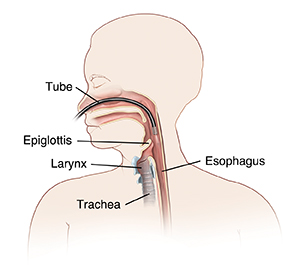Understanding Fiberoptic Evaluation of Swallowing (FEES)
A fiberoptic evaluation of swallowing (FEES) test is used to see if you have trouble swallowing. This condition is called dysphagia. It often affects older adults. It can lead to serious problems, such as lung infections. The FEES test uses a thin, flexible tube with a tiny light and camera on the end (endoscope). This tube is put into your nose and down your throat. Parts of your throat are viewed as you swallow. The test is done by a speech-language pathologist (SLP) or by an ear, nose, and throat (ENT) health care provider who treats swallowing problems. An SLP has special training in the areas of speech, language, voice, and swallowing.
Dysphagia and aspiration
When you swallow food, it passes from your mouth down into your throat. From there, the food moves down through a long tube (esophagus) and into your stomach. This is made possible by a series of actions from the muscles in these areas. If you have dysphagia, the muscles don’t work correctly. You may not be able to swallow normally.
The throat is also part of the system that brings air into your lungs. When you breathe, air enters your mouth and moves into the throat. The air then goes down into your main airway (trachea) and into your lungs. A flap of tissue called the epiglottis sits over the top of the larynx. This flap blocks food and drink from going down into the trachea when you swallow. Aspiration is when something enters the airway or lungs by accident. It may be food, liquid, or some other material. This can cause serious health problems, such as pneumonia. Aspiration can happen when a person has dysphagia.
Why a FEES test is done
A FEES test can help find out if you are having problems with any part of the swallowing process. An SLP or ENT health care provider will often first see how well you are swallowing with other simple tests. A FEES test is then done to get more information about your swallowing. If you have dysphagia, aspiration is always a risk, so dysphagia needs to be identified quickly. Many health problems can lead to dysphagia. Some examples are:
-
Stroke.
-
Head or neck cancer.
-
Spinal injury.
-
Head injury.
-
Major dental problems.
-
Conditions that reduce saliva (such as Sjogren syndrome).
-
Mouth sores.
-
Parkinson disease or other nervous system conditions.
-
Muscular dystrophy.
-
Blockage in the esophagus (such as from cancer or a stenosis).
You may need a FEES test if you have symptoms, such as:
-
Food sticking in your throat.
-
Trouble or pain while swallowing.
-
Certain breathing problems.
You may need the test even if you don’t have any dysphagia symptoms. You may still be at risk for aspiration.
How a FEES test is done
-
A numbing medicine (anesthetic) may be sprayed in your nose and throat. This is so you don’t feel the tube.
-
The health care provider quickly puts the tube through your nose and down into your throat.
-
The tube sits above your epiglottis for most of the viewing. It then can be moved down after each swallow so the vocal folds may be seen. The tube lets the provider see parts of your voice box, throat, and trachea on a video screen.
-
The endoscope may puff small amounts of air into your throat. This is to test the nerves in your throat.
-
You may swallow small amounts of food or liquid during the test. These will be dyed so they can be seen on the screen.

Risks of a FEES test
All procedures have some risks. The health care provider will work to reduce these risks. The risks of a FEES test include:
Online Medical Reviewer:
Daphne Pierce-Smith RN MSN
Online Medical Reviewer:
Mahammad Juber Medical Researcher
Online Medical Reviewer:
Marianne Fraser MSN RN
Date Last Reviewed:
2/1/2025
© 2000-2025 The StayWell Company, LLC. All rights reserved. This information is not intended as a substitute for professional medical care. Always follow your healthcare professional's instructions.